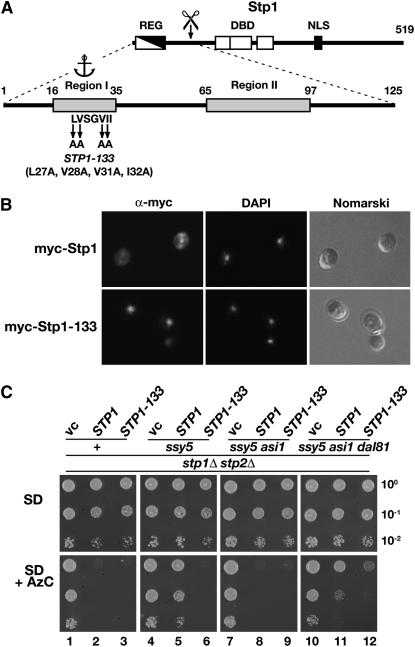Figure 3.—
The STP1-133 mutation abolishes cytoplasmic retention and enables SPS sensor-regulated gene expression in the absence of Dal81. (A) Schematic of Stp1. The location of the inhibitory regulatory domain (REG), the DNA binding domains (DBD), and putative nuclear localization sequence are depicted in the full-length Stp1 (519 aa). Conserved Region I (aa 16–35) containing sequences important for cytoplasmic retention (anchor) and Region II (aa 65–97) are indicated in the enlargement of the N-terminal domain (1–125 aa). The alanine substitution mutations of the STP1-133 allele are shown (Andréasson and Ljungdahl 2004). (B) Indirect immunolocalization of myc-Stp1 (pMB31) and myc-Stp1-133 (pMB45) in strain CAY60 (stp1Δ). Cells were grown in SD medium under noninducing conditions to an OD600 of 0.8 and fixed. Left to right: α-myc monoclonal antibody (9E11)-dependent Alexa Fluor 488 fluorescence; DAPI staining; and cells viewed by Nomarski optics. (C) Phenotypic analysis of the constitutive active STP1-133 allele and the dal81Δ null mutation. Plasmids pRS316 (vc), pMB10 (STP1), and pMB44 (STP1-133) were introduced into a stp1Δ stp2Δ mutant (+, CAY123) and into stp1Δ stp2Δ strains carrying ssy5Δ (MBY93), ssy5Δ asi1Δ (MBY102), and ssy5Δ asi1Δ dal81Δ (MBY124). The strains were grown on SC (-ura) medium. Aliquots of 10-fold serial dilutions in water were spotted on SD medium containing leucine (SD) and SD-containing leucine and 0.33 mM AzC (SD + AzC). Plates were incubated at 30°.

